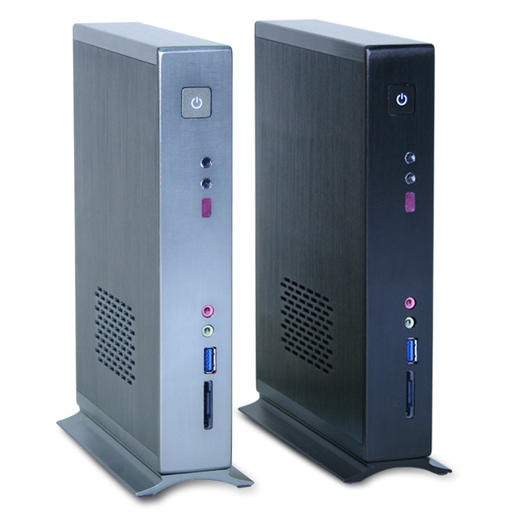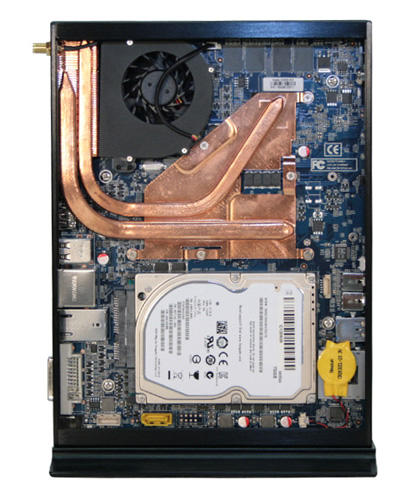
Polywell's i2303 packs a ton of awesome into a teeny-weeny little box.
There's a lot to love about the nettop concept. The small form factor, the quiet operation, the power efficiency—they all make a nettop seem like the perfect casual workstation. Unfortunately, along with all those good features comes the unwelcome reality of slow performance and underwhelming responsiveness. I recently had the opportunity to review the Polywell i2303, which takes two concepts and mashes them together to form a product much better than the sum of its parts. Much like the combination of peanut butter and chocolate, this workstation from Polywell is better than a nettop and better than a powerhouse workstation. It's both.
The i2303 is marketed for use in digital signage, HTPC and as a Linux workstation. For this review, I focused on the latter. Because the market is full of great HTPC units, I wanted to see if this nondescript box could really cut the mustard as a workstation. The answer is an overwhelming yes.
The body of the i2303 is about the size of a standard nettop device, or maybe just a bit bigger. The chassis is 1.55" wide, 6.6" deep and 9.1" tall. The included stand makes it a bit bigger, but that's the point of the stand—to help it stand up. The entire unit, including the stand, is metal. It's quite solid and feels strong enough to use as a jack stand for your car. (I'm sure that would void any warranty, so I don't suggest testing my theory.)
The design is simplicity at its best. The front sports a power button, activity LEDs, microphone and headphone jacks, a USB 3.0 port and an SD card slot (Figure 1). Both sides are vented, but the metal chassis is thick enough that the vents don't weaken the structure at all.

Figure 1. Silver or black—no more, no less (photo from polywell.com).
Flipping the unit over reveals a generous assortment of ports (Figure 2): a rear analog speaker jack, an external 802.11n antenna (removable with standard connector for larger antenna), an optical audio port, HDMI, four USB 2.0 ports, an eSATA port, Gigabit Ethernet, DVI and power connector. The power is a 19V DC connector, which is common in computers this size. The silence of this noiseless design is a fair trade for the inconvenience of an external transformer. The included power cord is very long with the transformer in the middle of its length, so it doesn't take up more than a single plug like wall warts often do.
Notable on this unit is a lack of a standard VGA port. Although a DVI-VGA converter dongle certainly will accommodate a VGA monitor, it does hint to the unit's higher-end internals. The massive copper heatsink is visible from the back as well. That too hints to the unit being more than meets the eye, but from an aesthetic standpoint, I think the copper looks cool showing through.
A peek inside (Figure 3) shows pretty much what you'd expect. The design is more akin to a high-end laptop than a desktop, but with the nettop form factor, that makes sense. Most notable is the large heatsink, efficiently designed to get heat away from the CPU and GPU with the aid of a blower fan. I've been hinting this whole time about the unit's specs, but here is a list of the specifications this review unit boasts:
Intel Core i5-2467M mobile processor.
NVIDIA GeForce 520 graphics card with 1GB graphics memory.
DVI dual-link graphics port supports 2560x1600 high-resolution display.
HDMI output supports dual-display configuration.
8GB DDR3 memory.
20GB SLC mSATA SSD (super speed) for OS and swap files.
500G 2.5" SATA 7200RPM hard drive for data storage.
Gigabit Ethernet, 802.11n Wi-Fi + Bluetooth.
Ubuntu Linux.
DC19V low-voltage power adapter.

Figure 3. The compact design necessitates the well-placed heatsink (photo from polywell.com).
Reading the specifications is more like reading the specs for a high-end desktop machine than a compact unit like this. Since I opened the box before looking at the packing slip (my wife says this is a typical guy move), I did a double-take when first looking at the hardware list.
The CPU is a mobile chip, but it's an i5 Sandy Bridge processor. Because the i2303 looks like a unit that should be sporting an Atom processor, the i5 option is impressive. Although the larger CPU is certainly part of the reason this unit has a cooling fan, even under heavy load, the unit is very quiet.
Graphics with computers of this size are always an interesting topic. Although most nettop units support acceleration for 1080p video playback, they usually fall short for other GPU-intensive tasks. I'm only a casual gamer, but with the i2303's NVIDIA GeForce 520 chip, I was able to play 3-D shooters at a fairly high resolution without notable frustration. Although this certainly isn't a gaming rig, the GPU was capable enough for more than just Solitaire. In fact, this is the unit I used for the Trine 2 review in the UpFront section of this issue, and it played quite nicely.
I didn't test the memory speed, since for the most part memory is as memory does, but the amount of memory included is impressive. Again, the tiny plain-Jane case is misleading, and 8GB of DDR3 memory was a welcome surprise. This boon of memory may be part of the reason large games worked so well, as the computer had plenty of room for memory-intensive applications.
With all the impressive features the i2303 boasts, my absolute favorite feature is the hard drive system. In Figure 3, you can see there is a standard 500GB SATA drive, which although speedy itself at 7200RPM, is there only for bulk storage. The system has an integrated 20GB SLC-based SSD designed for storing the OS and swap files. (See the sidebar for an explanation on SLC vs. MLC.) Because the OS is hosted on a blazing-fast SSD, it means the boot time is measured in seconds. It also means applications launch lightning-fast, but more on that later.
I've heard mixed reviews from folks using the new all-in-one hybrid hard drives that have both SSD and HDD components to increase speed. The concept is brilliant, but because Linux so easily uses multiple devices for different partitions, Polywell's multidrive setup works perfectly. For my test, I put everything but /home on the SSD, and with a few tweaks, it worked well.
Once the computer boots up, which with my Xubuntu 12.04 system takes less than 15 seconds, it feels like a computer running from RAM. The menus are snappy, the applications start up immediately, and Internet connectivity, whether via LAN or wireless, works flawlessly.
As far as functionality goes, the computer behaves much like you'd expect once you know its specifications. All hardware was detected properly; everything seems to function correctly, and there were no odd configuration steps required to get full functionality. Although this is largely credited to Linux developers, it's fair to point out the i2303 uses standard-enough hardware that it works with Linux out of the box. It also ships with Linux out of the box, which always is appreciated by folks not wishing to pay for a Microsoft Windows license they'll never use.
It seems every time I have distinct partitions set up on a computer, months later, I find that I estimated my needs incorrectly. I knew I wanted to install the operating system and swap files on the 20GB SSD, but I did have concerns about running out of space.
I spent a lot of time thinking about how best to partition the two drives, but in the end, I put the root partition on the SSD and the /home partition on the 500GB SATA hard drive. As you can imagine, my concern was that the /var directory would fill the limited space quickly. I strongly considered putting only the /boot and /usr partitions on the SSD, but I really wanted to see just how fast the computer could be.
Because I installed a handful of games, several of which were quite large, one of the first things I had to do was make a symbolic link to the /opt directory and place it on the hard drive. If I start to have problems with the /var directory, I'll likely do the same. I decided that because Linux is so flexible with symbolic links, I'd be better off putting everything but /home on the SSD and carve off problem areas later. I love Linux.
As the bulk of my games are on the /opt partition, they do load from the hard drive instead of the SSD. It means a couple more seconds to adjust my headphones while I wait for games to load, but it doesn't affect the load time of other applications, nor does it slow down boot time. That said, the 7200RPM SATA drive is no slouch, so even from the hard drive, things load acceptably fast.
There's a lot to love about the Polywell i2303. Although it certainly would make a wonderful computer for digital signage or HTPC, I think both tasks would be a waste of the unit's abilities. If I had to pick my favorite things, I guess they'd be these:
Dual SSD/HDD combination.
Above-average graphic performance for such a compact unit.
Rock-solid construction.
Impressive feature list.
The last item on my list is easy to overlook. This little unit has a few features that surprised me. The USB 3.0 port, the dual analog speaker jacks, Bluetooth and detachable antenna are just a few.
There were a few minor quirks to the unit. The antenna, while removable, does jut out a bit in the back. I worry if placed in a busy environment it might get broken off. I also noticed whenever I loaded a Web page with Flash on it, the system fan kicked on full blast for a moment. I suspect that is as much the fault of NVIDIA and Adobe as anyone, but it still caught my attention on a regular basis.
Some might be turned off by the absolute stark design of the case. This computer is a sturdy metal box and has no frills. I personally think that is a plus, but if you want glowing LED lighting and an aerodynamic design, this computer isn't for you.
At first glance, the $799 price tag seems steep, but once you realize how much computer you're getting, I think it's quite reasonable. If you're just hoping to get a cheap nettop computer, this probably isn't the unit for you. If you're looking for an energy-efficient workstation-class device, $799 isn't a bad price.
I won't lie; I love this little computer. If I could use an automotive metaphor, it's a total sleeper. What seems like a piddly little nettop is actually a very functional workstation. I'm a writer, a casual gamer and I occasionally compile software. Even though my demands aren't terribly high, I still prefer a computer that is fast and responsive. This computer ticked every box for me. For more information, check out www.polywell.com/us/oem/i2303.asp.